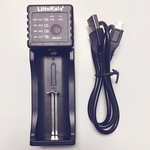Fabulous single-cell multi-chemistry charger for about $5 each
Buy 3 and they are US$3.62 AU$5.01 each.
Good reviews, great bang for the bucks!
Proper changing algorithms and voltage termination
1.2V Ni-CD & Ni-MH
3.7V Li-Ion
3.2V LifePo4
3.8V Li-Ion
- It Auto-selects the first 2 of those voltages, or override manually for 3.2 and 3.8V
- Defaults to 500mA charge, a 2-second button hold will manually override to 1 Amp
Runs off 1A USB port, seems to include a MicroUSB cable.
Bonus function as a USB Power Bank if you drop a Lithium cell in it (say a 18650)
I have other more advanced chargers, dischargers, analysers, testers, etc. I bought these as a quick and easy to use charger for the family to use. Will connect three up to a 5 port Blitzwolf Mains to USB adaptor.
Review by HKJ: http://lygte-info.dk/review/Review%20Charger%20LiitoKala%20L…
BudgetLightForum discussion: http://budgetlightforum.com/node/43690
Mods to adjust voltage and current: http://budgetlightforum.com/node/44086
Teardown (Russian): http://www.mobilpower.ru/article_info.php?articles_id=25
Cheers!




what is a trustworthy 18650 battery?
i dont know too much about LiOns, but are there other common batteries other than 18650? any particular reason why the 18650 is bigger than say consumer rechargable batteries?